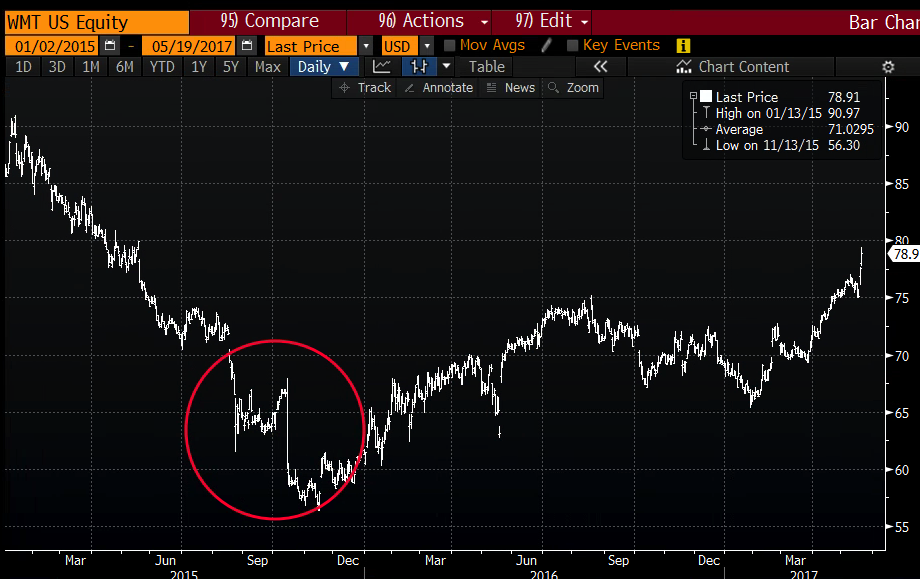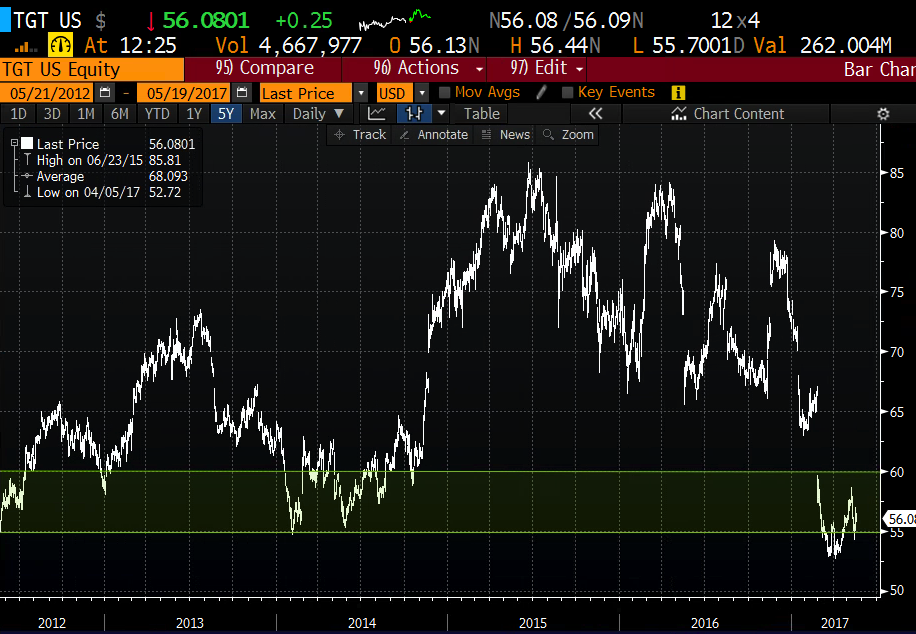On Wednesday Target (TGT) beat Q1 consensus eps estimates due in large part to better than expected same store sales comps (-1.3% vs estimates of -3.7%). In the earnings release, CEO Brian Cornell laid out the known challenges, but as the eps beat $1.21 vs .91 estimate might have shown, management might have lowered guidance enough in late March to set up for a series of beats throughout 2017:
After starting the quarter with very soft trends, we saw improvement later in the quarter, particularly in March,
We are in the early stage of a multi-year effort to position Target for profitable, consistent long-term growth, and while we are confident in our plans, we are facing multiple headwinds in the current landscape. As a result, we will continue to plan our business prudently while preparing our team to chase business when we have an opportunity.
One of those headwinds is obviously the consumer buying trends that are forcing companies like TGT to play catch up (fast). In the quarter just reported, TGT saw online sales rise 22% year over year, representing 4.3% of their total sales. This a deceleration from Q4’s 34% growth. The company stated at their analyst meeting in March they will ‘invest” over $2 billion a year over the next few years, spending on beefing up e-commerce offering, logistics/shipping, revamping stores and promotions/low prices. I suspect an acquisition similar to Walmart’s (WMT) $3 billion purchase of Jet.com is likely in the cards in the not so distant future as a means to jumpstart their omnichannel selling strategy. For comparison’s sake, WMT’s digital sales growth accelerated meaningfully in their latest quarter, only the third since Jet was integrated, growing 63% year over year, that off of a much larger base than Target’s.
Wall Street analysts expect eps to decline mid teens this current year, with sales, flat, TGT trades at a significant discount to peer WMT on a P/E basis, 13.3x current fiscal year to about 18x. What’s interesting to me about this is that it wasn’t too long ago that WMT management kitchen-sinked their full-year guidance for 2016 with similar talk about transition, investment, and promotional ways to lure online shoppers:

It’s my view that the devastation in department store stocks and many apparel makers should not discount the possibility that some retailers are in the early innings of transitions that may yield years of double-digit e-commerce growth rates. The survivors able to adapt will see investors re-rate these stocks while others continue their march to zero. Target could be one, for a whole host of reasons that differentiate it from departments stores.
Bloomberg ran a story yesterday on WMT’s push into e-commerce, and they made a few points about acquiring new customers through online sales channels (emphasis mine):
WMT CEO has used the Jet acquisition as a catalyst for online growth. After buying that business in September, he put co-founder Marc Lore in charge of U.S. e-commerce. Wal-Mart followed up with some smaller deals, snapping up outdoor retailer Moosejaw and women’s apparel seller ModCloth earlier this year.
…..
Wal-Mart has found that offering online groceries brings in new customers, and those shoppers are typically young families “who don’t want to drag their kids around a Wal-Mart,” according to Jennifer Bartashus, an analyst at Bloomberg Intelligence. About 42 percent of Wal-Mart’s regular monthly shoppers are members of Amazon’s Prime program, according to research firm InfoScout.
……
The acquisitions have helped burnish Wal-Mart’s online image, though the majority of e-commerce growth came from its longstanding Walmart.com site last quarter. Its digital growth rate was nearly triple that of Target. Amazon’s sales of so-called retail products climbed 16 percent last quarter.
Wal-Mart’s online expansion hasn’t come cheap, though. Its expenses grew faster than sales in the first quarter… Wal-Mart has pledged to reverse that trend over the course of the year.
You get the point, WMT is up 14% this year, dramatically outperforming the S&P 500 and most retail peers (the XRT is down 7% ytd).
And Target may be nearing a similar inflection point that WMT experienced n the last year. The stock is trading well below a market multiple, paying a dividend that yields 4.25% and possibly having sentiment bad enough and expectations low enough that with a string of beats could put in a similar bounce. $55 – $60 appears to be a fairly decent technical support level:

If you agree that TGT’s poor sentiment, low expectations, poor stock performance, cheap valuation and the potential for acquisitions that would accelerate e-commerce growth meaningfully could turn the stock around in late 2017, a defined risk strategy that positions for a Q3 rally make sense:
So what’s the trade? A Call Calendar…
TGT ($56) Buy July / Oct 60 Call Calendar for $1
-Sell 1 July 60 call at 55 cents
-Buy 1 Oct 60 call for 1.55
Break-Even on July expiration:
Best case scenario stock rallies towards 60 on July expiration and the short call expires worthless, covering the decay in the Oct call that you own while that gains due to to the rise in the stock.
Worst case the stock goes much lower, or much higher through the 60 strike. But in that case the most at risk is $1, therefore well defined.
Rationale: Putting in a bottom in its stock will be a drawn out process for TGT. This trade defines risk to just $1 and offers upside exposure all the way out until October, with various scenarios to continue to roll and reduce risk. Again, the ideal situation is for the stock to stabilize and approach the 60 level by July. At that point the July call can be closed and rolled.